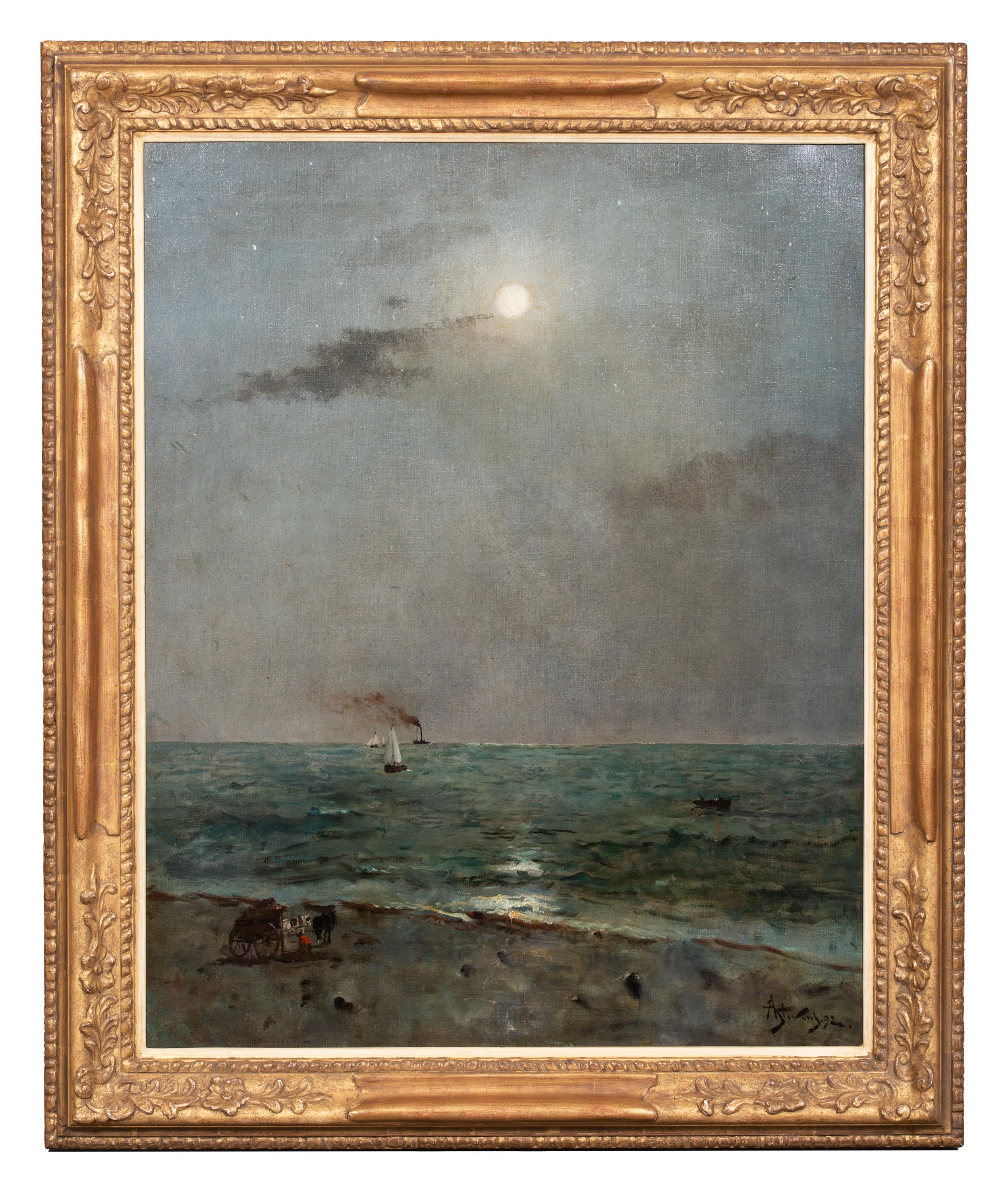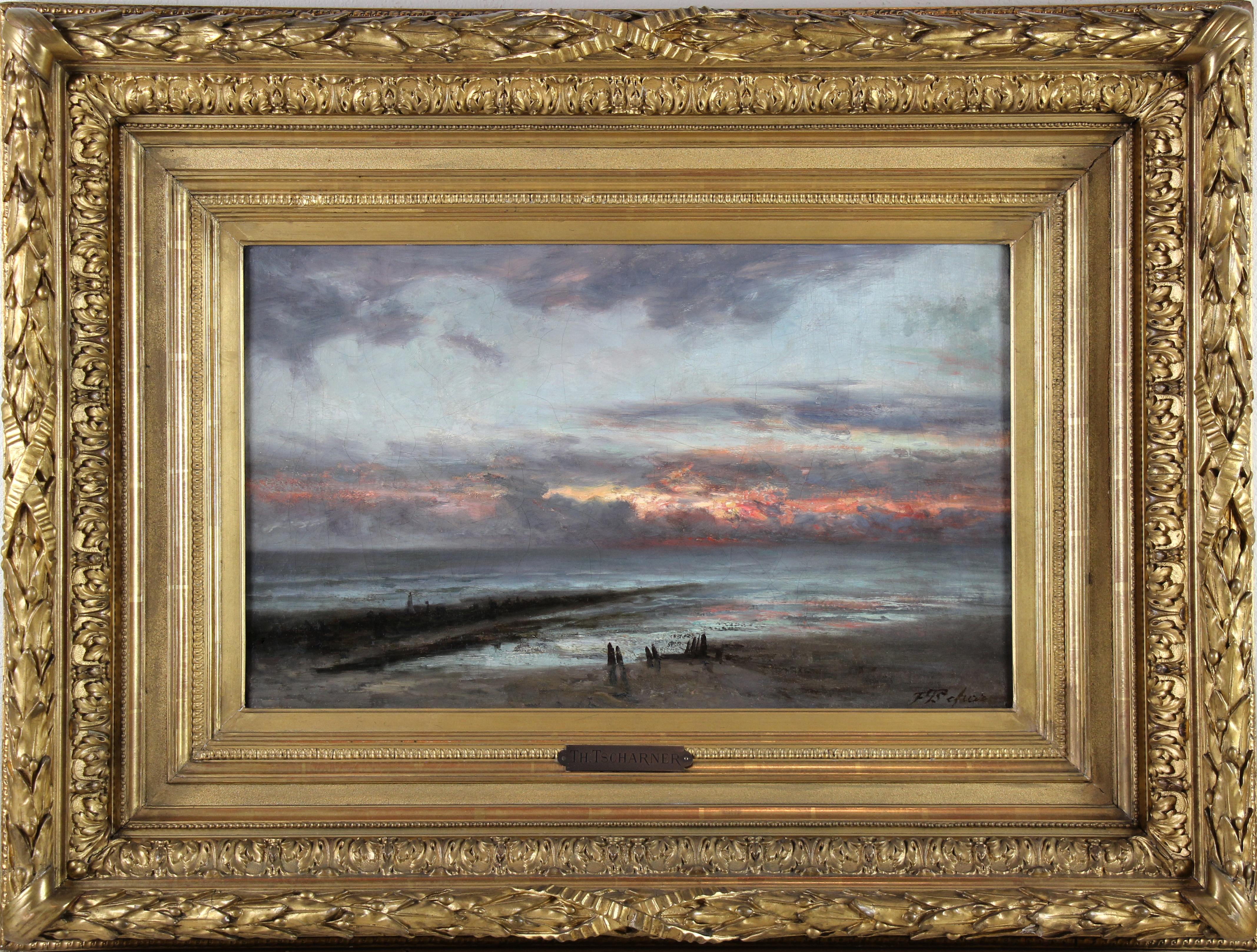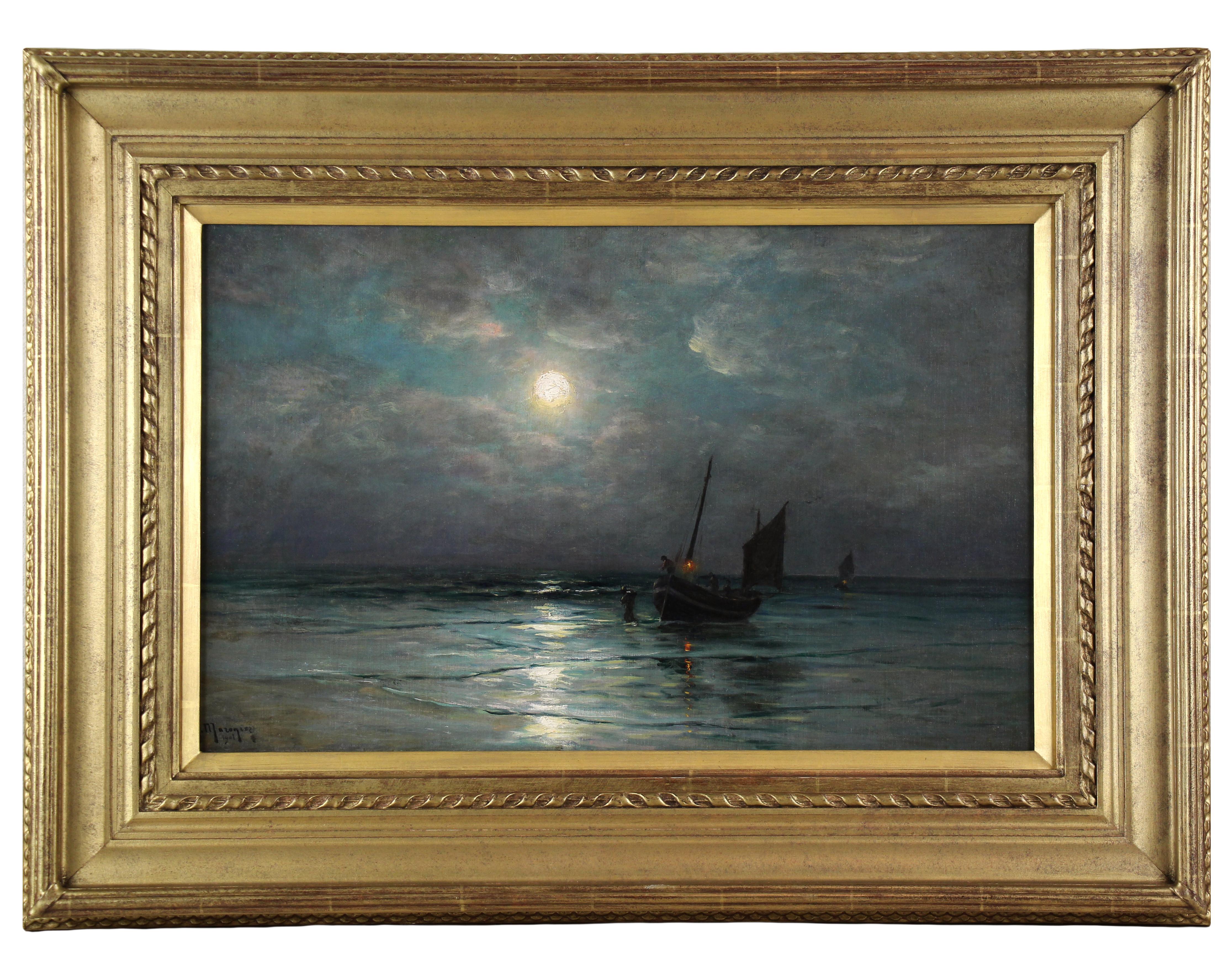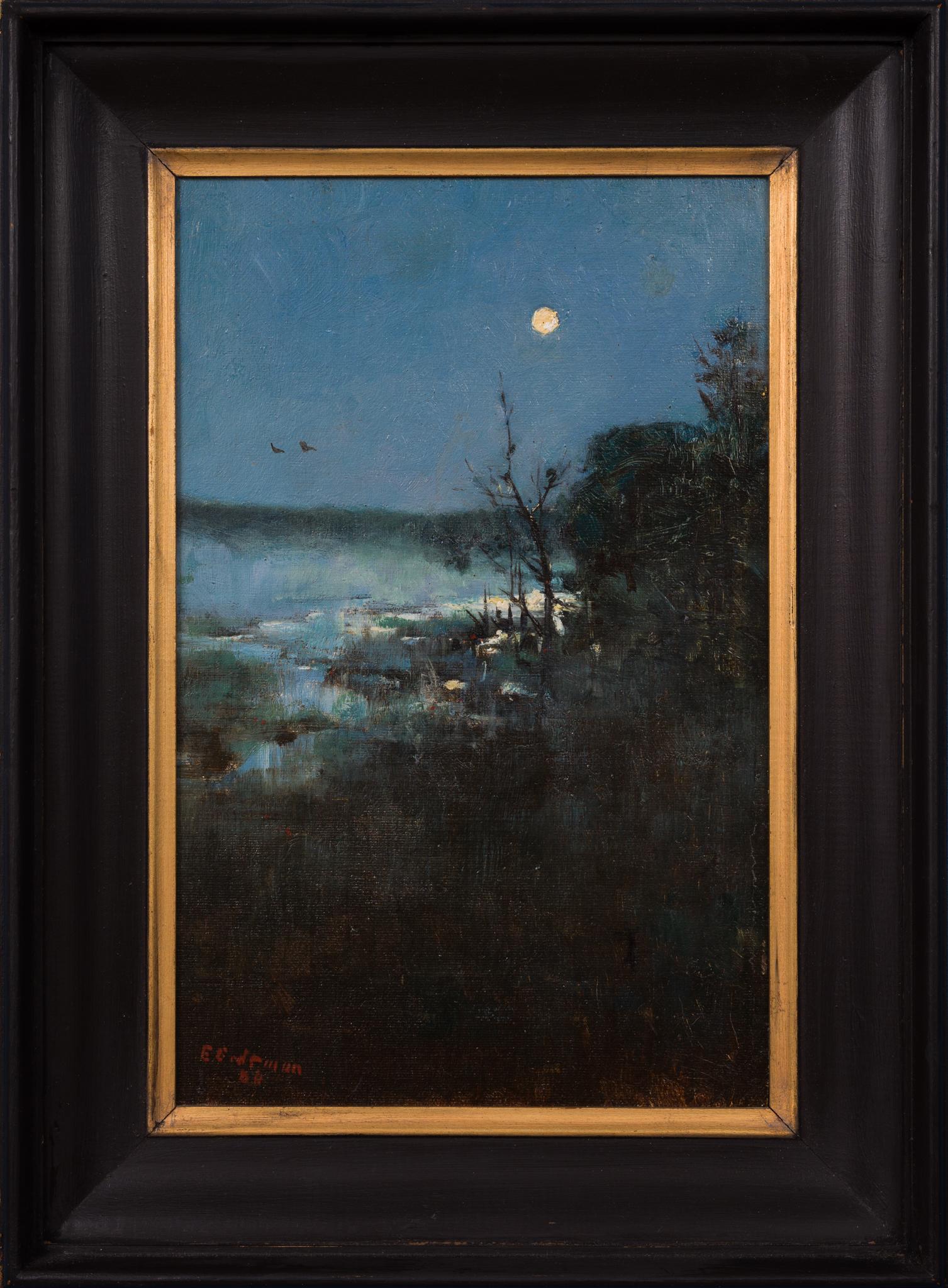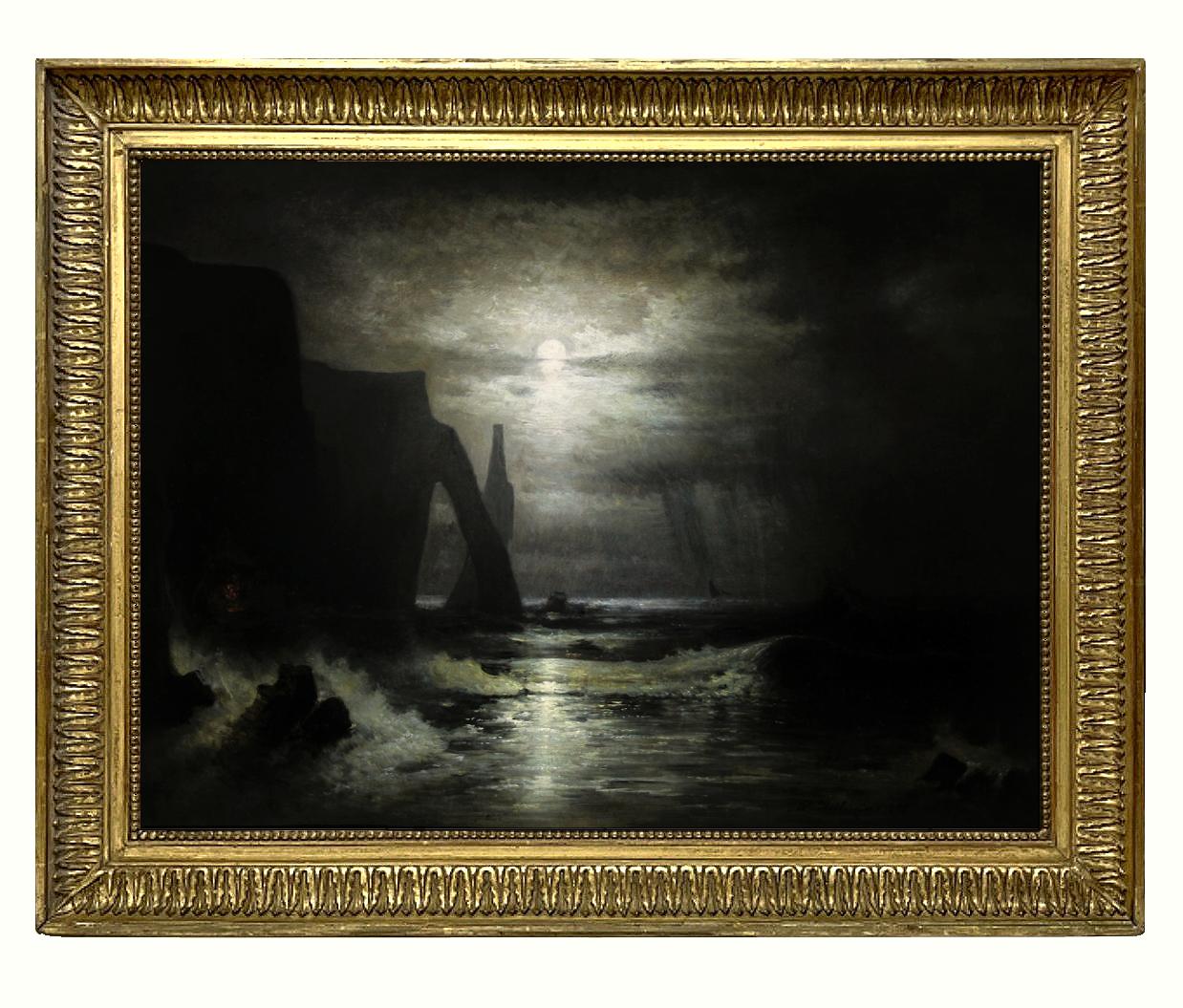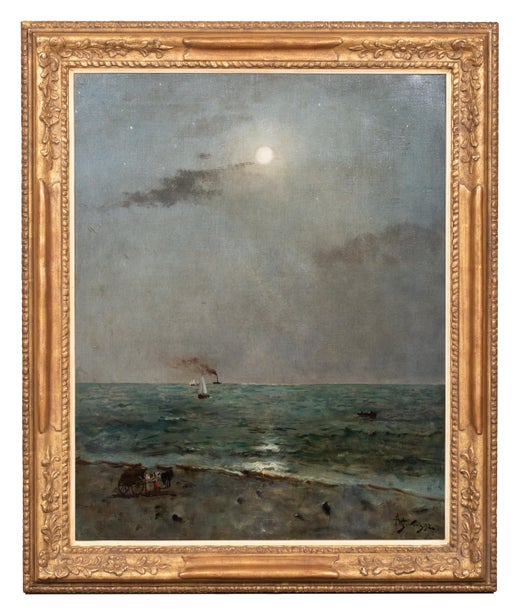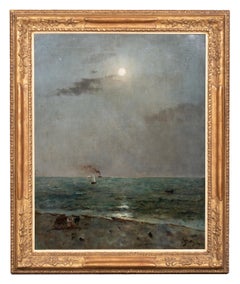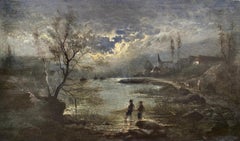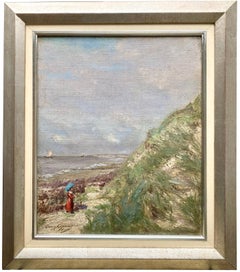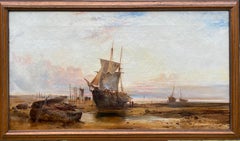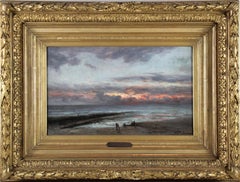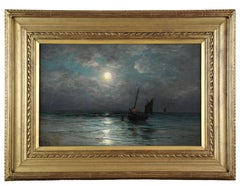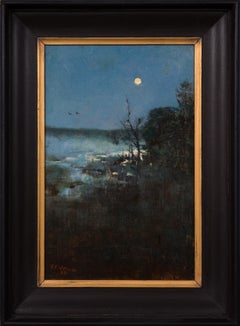Items Similar to 'Moonlight on the Sea' by Alfred Stevens ( Brussels 1823 – 1906 Paris )
Want more images or videos?
Request additional images or videos from the seller
1 of 18
Alfred Stevens'Moonlight on the Sea' by Alfred Stevens ( Brussels 1823 – 1906 Paris )1892
1892
$30,804.40
£23,331.71
€26,000
CA$42,940.69
A$46,739.02
CHF 24,619.83
MX$568,934.05
NOK 308,297.73
SEK 289,436.01
DKK 198,052.60
About the Item
Alfred Stevens
Brussels 1823 – 1906 Paris
Belgian Painter
'Moonlight on the Sea'
Signature: signed lower right and dated 1892 ‘A Stevens 92'
Medium: oil on canvas
Dimensions: image size 81 x 65 cm, frame size 97,5 x 81,5 cm
Provenance:
Collection M. Klein, 1900
Galerie Petit, Paris, 18 June 1926, no. 22
Private collection, Europe
De Vuyst, Belgium, 1998
Galerie Kupperman, Amsterdam
Private collection, The Netherlands
Exhibitions:
Exposition of the Works of Alfred Stevens, Palais des Beaux-Arts, Brussels, 1928
Retrospective Alfred Stevens, École des Beaux-Arts, Paris, 1900, no. 100
Literature:
A. Stevens, Mercatorfonds, Brussels, p. 100
Alfred Stevens, François Boucher, Ed. Rieder, Paris, 1930, illustrated on p. 36
Documentation by Mrs. Christiane Lefebvre, 1998
Biography: Alfred Émile Léopold Stevens (11 May 1823 – 24 August 1906) was a prominent Belgian painter renowned for his depictions of elegant modern women. His works, characterized by a realistic style and meticulous attention to detail, reveal the influence of 17th-century Dutch genre painting. While he initially gained attention for his social realist portrayal of the hardships faced by impoverished vagrants, he later achieved great critical and popular success with his portrayals of upper-middle class Parisian life. Notably, he often used the same models repeatedly, with some of them being identified in the infamous Book of the Courtesans, a confidential surveillance file maintained by the Paris vice squad, as noted by author Summer Brennan.
Stevens was born in Brussels, into a family deeply connected with the visual arts. His older brother Joseph (1816–1892) and his son Léopold (1866–1935) were both painters, while his other brother Arthur (1825–1899) was an art dealer and critic. His father, a veteran of the Napoleonic wars under the army of William I of the Netherlands, was an art collector with a notable collection of watercolors by Eugène Delacroix and other esteemed artists. Stevens’s upbringing was influenced by the environment of Café de l’Amitié, run by his maternal grandparents in Brussels, which served as a meeting place for prominent figures from the political, literary, and artistic spheres. Following the death of his father in 1837, Stevens left middle school to enroll at the Académie Royale des Beaux-Arts in Brussels. There, he came under the tutelage of François Navez, a Neo-Classical painter and former student of Jacques-Louis David, who was both the director of the academy and an old acquaintance of Stevens’s grandfather. Following a traditional curriculum, he initially drew from casts of classical sculptures and later transitioned to drawing from live models. In 1843, Stevens journeyed to Paris to join his already established brother, Joseph. He gained admission to the École des Beaux-Arts, the preeminent art school in Paris, although claims of him being a student of the director, Jean Auguste Dominique Ingres, are likely unfounded. One of his early works, The Pardon or Absolution (Hermitage, St. Petersburg), signed and dated 1849, showcased his mastery of a conventional naturalistic style influenced by 17th-century Dutch genre painting.
Stevens’s work was first publicly exhibited in 1851, when three of his paintings were featured at the Brussels Salon. He received a third-class medal at the Paris Salon in 1853, followed by a second-class medal at the Universal Exposition in Paris in 1855. His painting Ce qu’on appelle le vagabondage [What is called vagrancy] (Musée d’Orsay, Paris) garnered attention from Napoleon III, leading to a change in policy regarding the use of soldiers to remove the poor from the streets. Two other paintings displayed at the Salon in Antwerp in the same year, Chez soi or At Home and The Painter and his Model, introduced subjects from “la vie moderne” that became characteristic of his oeuvre: elegant young women dressed in contemporary fashion and artists in their studios. In 1857, Stevens made his first significant sale to a private collector when Consolation was purchased for a rumored 6,000 francs by the Berlin collector and dealer Ravéné. He and his brother also became part of the artistic milieu in Paris, frequenting salons hosted by Princess Mathilde and popular cafes, where they mingled with the likes of the Goncourt brothers, Théophile Gautier, and Alexandre Dumas. Stevens married Fanny Juliette Albertine Marie Hortense Blanc (1836-1891), a member of a wealthy Belgian family and a long-time acquaintance of the Stevens family, in 1858. The wedding was witnessed by the renowned painter Eugène Delacroix. The couple had four children: Leopold, Jean, Catherine, and Pierre. Stevens depicted his wife in numerous portraits, including Regrets and Memories. After her passing, he expressed enduring grief at her loss. During the 1860s, Stevens rose to considerable acclaim for his paintings of fashionable modern women.
His exhibits at the Salons in Paris and Brussels garnered favorable critical reception and attracted enthusiastic buyers. Notably, his work La Dame en Rose or Woman in Pink (Royal Museums of Fine Arts of Belgium, Brussels), completed in 1866, exemplified a blend of a stylishly attired woman in an interior setting with a detailed exploration of Japanese objects, reflecting his early enthusiasm for Japonisme. In 1863, he was awarded the Legion of Honor (Chevalier) by the French government. In 1867, he secured a first-class medal at the Universal Exposition in Paris, and his rank was elevated to Officer of the Legion of Honor. His social circle included prominent figures such as Édouard Manet, Edgar Degas, Charles Baudelaire, Berthe Morisot, James Abbott McNeill Whistler, Frédéric Bazille, and Puvis de Chavannes, and he was a regular patron of the Café Guerbois in Paris.
Stevens participated in the defense of Paris during the Franco-Prussian War but returned to Belgium with his family before the Paris Commune. They later returned to Paris, where Stevens continued to enjoy critical acclaim and success among collectors. In 1875, he purchased a grand house and garden on rue des Martyrs in Paris, which appeared in his paintings as well as those of other artists, such as Édouard Manet’s The Croquet Party. However, he was forced to vacate the property in 1880 to make way for the construction of a new street, which was eventually named after him. In 1878, he was appointed Commander of the Legion of Honor and was awarded another first-class medal at the Salon.
Despite earning a significant income from the sale of his paintings, Stevens faced financial difficulties during the 1880s due to a combination of poor investments and excessive spending. His financial strain was further compounded by the cost of summer trips to the seaside, which a doctor had advised him to take for health reasons in 1880. Consequently, when the Paris dealer Georges Petit offered him 50,000 francs to finance his vacations in exchange for paintings created during that period, Stevens agreed. This arrangement, spanning three years, resulted in the sea becoming a significant subject in his work, and over the course of his career, he produced numerous views of popular resorts along the Normandy coast and the Midi in the south. Many of these works were executed in a sketchy style influenced by the Impressionists.
Stevens also began teaching private students, including the renowned actress Sarah Bernhardt, who became a close friend, and the American artist William Merritt Chase. Other notable students included Berthe Art, Charles Bell Birch, Jules Cayron, Marie Collart-Henrotin, Louise De Hem, Harriet Campbell Foss, Georgette Meunier, Lilla Cabot Perry, Jean-Paul Sinibaldi, and Fernand Toussaint. The most significant work from the latter part of Stevens’s career was the monumental Panorama du Siècle, 1789–1889, which he painted in collaboration with Henri Gervex. In this project, Stevens painted the women and intricate details, while Gervex focused on the male figures, with the assistance of fifteen assistants. The painting garnered significant acclaim when it was exhibited at the International Exhibition in Paris in 1889.
Stevens received several notable tributes during his lifetime. In 1895, a large exhibition of his work was held in Brussels, followed by a retrospective exhibition at the Ecole des Beaux-Arts in Paris in 1900, marking the first retrospective dedicated to a living artist by the institution. Supported by patrons led by the Comtesse de Greffulhe, the exhibition achieved both social prestige and widespread acclaim. In 1905, Stevens was the only living artist featured in a retrospective exhibition of Belgian art in Brussels. Despite these accolades, he struggled to sell enough of his work to alleviate his financial difficulties. Having outlived his brothers and the majority of his friends, Stevens passed away in Paris in 1906, residing alone in modest accommodations while remaining in touch with his four children.
- Creator:Alfred Stevens (1823 - 1906)
- Creation Year:1892
- Dimensions:Height: 38.39 in (97.5 cm)Width: 45.48 in (115.5 cm)Depth: 3.94 in (10 cm)
- Medium:
- Movement & Style:
- Period:
- Condition:The artwork is elegantly displayed within a high-quality frame, impeccably preserved in its excellent condition. This piece is presented in a state suitable for immediate gallery hanging, having undergone professional review.
- Gallery Location:Knokke, BE
- Reference Number:1stDibs: LU2006217120312
Alfred Stevens
Alfred Émile Léopold Stevens (1823–1906) was a celebrated Belgian painter renowned for his depictions of elegant modern women, often inspired by 17th-century Dutch genre painting. Born in Brussels to a family immersed in the arts, he studied at the Académie Royale des Beaux-Arts and the École des Beaux-Arts in Paris. Stevens first gained recognition for his social realist works portraying the struggles of the poor but later found greater success with his detailed portrayals of fashionable Parisian life. His work earned him numerous accolades, including the Legion of Honor, and he became a key figure in the Parisian art scene, socializing with artists like Édouard Manet and Edgar Degas. Despite financial troubles later in life, Stevens continued to paint and teach, mentoring artists such as Sarah Bernhardt and William Merritt Chase. His later works included seascapes influenced by Impressionism, and he collaborated on the monumental "Panorama du Siècle." He received significant honors during his lifetime, including a major retrospective at the École des Beaux-Arts in 1900. Stevens passed away in Paris in 1906, leaving behind a legacy as one of the leading painters of his era.
About the Seller
5.0
Vetted Professional Seller
Every seller passes strict standards for authenticity and reliability
Established in 1998
1stDibs seller since 2022
29 sales on 1stDibs
Typical response time: 4 hours
- ShippingRetrieving quote...Shipping from: Knokke, Belgium
- Return Policy
Authenticity Guarantee
In the unlikely event there’s an issue with an item’s authenticity, contact us within 1 year for a full refund. DetailsMoney-Back Guarantee
If your item is not as described, is damaged in transit, or does not arrive, contact us within 7 days for a full refund. Details24-Hour Cancellation
You have a 24-hour grace period in which to reconsider your purchase, with no questions asked.Vetted Professional Sellers
Our world-class sellers must adhere to strict standards for service and quality, maintaining the integrity of our listings.Price-Match Guarantee
If you find that a seller listed the same item for a lower price elsewhere, we’ll match it.Trusted Global Delivery
Our best-in-class carrier network provides specialized shipping options worldwide, including custom delivery.More From This Seller
View All'Moonlight on the Sea' by Alfred Stevens (Brussels 1823 – 1906 Paris) dated 1892
By Alfred Stevens
Located in Knokke, BE
Alfred Stevens
Brussels 1823 – 1906 Paris
Belgian Painter
'Moonlight on the Sea'
Signature: signed lower right and dated 1892 ‘A Stevens 92'
Medium: oil on canvas
Dimensions: image size 81 x 65 cm, frame size 97,5 x 81,5 cm
Biography: Alfred Stevens was born in Brussels, into a family deeply connected with the visual arts. His older brother Joseph (1816–1892) and his son Léopold (1866–1935) were both painters, while his other brother Arthur (1825–1899) was an art dealer and critic. His father, a veteran of the Napoleonic wars under the army of William I of the Netherlands, was an art collector with a notable collection of watercolors by Eugène Delacroix and other esteemed artists.
Stevens’s upbringing was influenced by the environment of Café de l’Amitié, run by his maternal grandparents in Brussels, which served as a meeting place for prominent figures from the political, literary, and artistic spheres. Following the death of his father in 1837, Stevens left middle school to enroll at the Académie Royale des Beaux-Arts in Brussels. There, he came under the tutelage of François Navez, a Neo-Classical painter and former student of Jacques-Louis David, who was both the director of the academy and an old acquaintance of Stevens’s grandfather. Following a traditional curriculum, he initially drew from casts of classical sculptures and later transitioned to drawing from live models. In 1843, Stevens journeyed to Paris to join his already established brother, Joseph. He gained admission to the École des Beaux-Arts, the preeminent art school in Paris, although claims of him being a student of the director, Jean Auguste Dominique Ingres, are likely unfounded. One of his early works, The Pardon or Absolution (Hermitage, St. Petersburg), signed and dated 1849, showcased his mastery of a conventional naturalistic style influenced by 17th-century Dutch genre painting.
Stevens’s work was first publicly exhibited in 1851, when three of his paintings were featured at the Brussels Salon. He received a third-class medal at the Paris Salon in 1853, followed by a second-class medal at the Universal Exposition in Paris in 1855. His painting Ce qu’on appelle le vagabondage (Musée d’Orsay, Paris) garnered attention from Napoleon III, leading to a change in policy regarding the use of soldiers to remove the poor from the streets. Two other paintings displayed at the Salon in Antwerp in the same year, Chez soi or At Home and The Painter and his Model, introduced subjects from “la vie moderne” that became characteristic of his oeuvre: elegant young women dressed in contemporary fashion and artists in their studios. In 1857, Stevens made his first significant sale to a private collector when Consolation was purchased for a rumored 6,000 francs by the Berlin collector and dealer Ravéné. He and his brother also became part of the artistic milieu in Paris, frequenting salons hosted by Princess Mathilde and popular cafes, where they mingled with the likes of the Goncourt brothers, Théophile Gautier, and Alexandre Dumas. Stevens married Fanny Juliette Albertine Marie Hortense Blanc (1836-1891), a member of a wealthy Belgian family and a long-time acquaintance of the Stevens family, in 1858. The wedding was witnessed by the renowned painter Eugène Delacroix. The couple had four children: Leopold, Jean, Catherine, and Pierre. Stevens depicted his wife in numerous portraits, including Regrets and Memories. After her passing, he expressed enduring grief at her loss. During the 1860s, Stevens rose...
Category
Late 19th Century Impressionist Landscape Paintings
Materials
Canvas, Oil
Edouard Moerenhout, Late 19th Century, Fishing in the River Meuse, Oil on Panel
Located in Knokke, BE
Moerenhout Edouard
Belgian Painter
Late 19th Century
"Fishing in the River Meuse"
Signature: Verso placed and signed "Pêcherie sur la Meuse ... E Moerenhout"
Medium: Oil on mahogany...
Category
Late 19th Century Realist Landscape Paintings
Materials
Oil, Wood Panel
'By the Sea' by Omer Coppens (Dunkirk 1864 – 1926 Ixelles) French-Belgian
By Omer Coppens
Located in Knokke, BE
Omer Coppens
Dunkirk 1864 – 1926 Ixelles
French-Belgian Painter
'By the Sea'
Signature: signed lower left 'Omer Coppens'
Medium: oil on canvas
Dimensions: image size 46,5 x 39 cm,...
Category
Early 20th Century Impressionist Landscape Paintings
Materials
Canvas, Oil
The North East Coast of England, Ralph Stubbs, Bridlington 1826 – 1879 Levisham
Located in Knokke, BE
The North East Coast of England
Stubbs Ralph
Bridlington 1826 – Levisham 1879
English Painter
Signature: Signed bottom right and dated 1861, verso stamp
Dimensions: Image size 58,5...
Category
19th Century Realist Landscape Paintings
Materials
Canvas, Oil
‘Fishermen’s Cove with two fishing boats on the beach’ by Johan Hendrik Meijer
By Johan Hendrik Louis Meijer
Located in Knokke, BE
Johan Hendrik Louis Meijer
Amsterdam 1809 – 1866 Utrecht
Dutch Painter
‘Fishermen’s Cove with two fishing boats on the beach’
Signature: signed lower right ‘L Meijer’
Medium: oil o...
Category
19th Century Romantic Landscape Paintings
Materials
Panel, Oil
'White Cliffs of Dover' by Johan Jacob Bennetter (1822 - 1904) Norwegian
Located in Knokke, BE
Johan Jacob Bennetter
Oslo, Norway 1822 -1904
Norwegian Painter
'White Cliffs of Dover'
Signature: signed lower right
Medium: oil on canvas
Dimensions: image size 41,50 x 63 cm, f...
Category
Late 19th Century Realist Landscape Paintings
Materials
Canvas, Oil
You May Also Like
Sur la Plage - Impressionist Oil, Figures in Coastal Landscape by Alfred Stevens
By Alfred Émile Léopold Stevens
Located in Marlow, Buckinghamshire
Signed and dated figures in seascape oil on panel by Belgian impressionist painter Alfred Emile Leopold Stevens. The work depicts an elega...
Category
1890s Impressionist Figurative Paintings
Materials
Oil, Panel
Oil painting on canvas coastal scene "Nightfall on the North Sea " ca. 1880
Located in Gavere, BE
Additional information:
Title: Coastal scene - Nightfall on the North Sea
Medium: oil on canvas
Signature: signed lower right
Provenance: Private collection Brussels
Canvas dimensio...
Category
1880s Impressionist Landscape Paintings
Materials
Gold Leaf
Coastal scene and fishing boats at moonlight, French Oil painting By G. Maroniez
Located in Gavere, BE
Maroniez is best known as an accomplished painter of the sea and the life of fishermen.
He painted mainly in Brittany ( France )
Museums and galleries holdings :
Boulogne: Mussel b...
Category
Early 1900s Impressionist Landscape Paintings
Materials
Oil, Wood Panel
Moonlit Reflections, Heyst-sur-Mer. Painted 1884
By Elias Erdtman
Located in Stockholm, SE
Elias Erdtman (Sweden, 1863–1945)
Moonlit Reflections, Heyst-sur-Mer
oil on canvas laid on board
signed E. Erdman och daterad -84
unframed: 29 x 18.5 cm (11.4 x 7.3 inches)
framed:...
Category
1880s Impressionist Landscape Paintings
Materials
Canvas, Oil, Board
French coastal scene of Étretat at moonlight by Karl Heilmayer dated 1898
Located in Gavere, BE
French coastal scene of Étretat at moonlight by Karl Heilmayer dated 1898 " SOLD WITHOUT FRAME "
A born Munich native, Karl Heilmayer, son of court act...
Category
1890s Landscape Paintings
Materials
Canvas, Oil
19th Century seascape oil painting of shipping by moonlight on the Medway
By Hubert Thornley
Located in Nr Broadway, Worcestershire
Hubert Thornley
British, (exh. 1858 -1898)
Moonlight on The Medway
Oil on canvas, signed, further inscribed in pencil to the stretcher verso
Image size: 9.5 inches x 15.5 inches
Size...
Category
19th Century Landscape Paintings
Materials
Canvas, Oil
